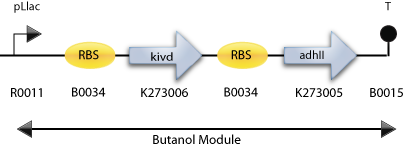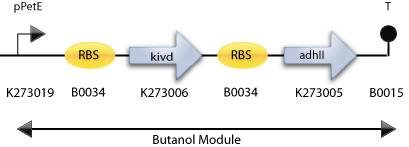Team:Uppsala-Sweden/Butanol
From 2009.igem.org
Karl.brune (Talk | contribs) (→The Constructs) |
Karl.brune (Talk | contribs) (→The Constructs) |
||
| Line 8: | Line 8: | ||
==The Constructs== | ==The Constructs== | ||
| - | We designed | + | We designed two final constructs (<partinfo>BBa_K273011</partinfo> & <partinfo>BBa_K273012</partinfo>) that actually only differ in the promoter, as our final host organism <i>Synechocystis sp PCC6803</i> does not allow the use of conventional inducible promoters. More information about pPetE, a cupper inducible promoter for <i>Synechocystis sp PCC6803</i>, can be found here <partinfo>K273019</partinfo>. |
<h3><partinfo>BBa_K273011</partinfo> : The Construct for Testing Purposes in <i>E. Coli</i></h3> | <h3><partinfo>BBa_K273011</partinfo> : The Construct for Testing Purposes in <i>E. Coli</i></h3> | ||
Revision as of 22:32, 19 October 2009

Contents |
The Butanol Approach
Our goal is to achieve photosynthetic production of butanol and its derivates with the cyanobacterium Synechocystis sp. PCC 6803 as the final host organism.
Background
Cyanobacteria have the capability to harvest the energy from the sun and convert it into other forms of energy. The natural way for these organisms is to store it as sugars or other carbohydrates in a way similar to plants. By introducing a casette of genes for isobutanol production, we would like to derive a cyanobacteria that produces butanol and its derivates.
The Constructs
We designed two final constructs ( & ) that actually only differ in the promoter, as our final host organism Synechocystis sp PCC6803 does not allow the use of conventional inducible promoters. More information about pPetE, a cupper inducible promoter for Synechocystis sp PCC6803, can be found here .
: The Construct for Testing Purposes in E. Coli

: The Final Construct for Synechocystis sp PCC6803

The Pathway
The original pathway to obtain branched-chain higher alcohols was proposed and succesfully established in E. coli by Shota Atsumi, Taizo Hanai and James C. Liao from the University of Californa, Los Angeles. [1] As we expect a broad range of higher alcohols, we will exemplarily demonstrate the biochemical mechanism at the pathway of isobutanol, the product we expect to be the most occuring one.

The precursor for isobutanol production is pyruvate, a central metabolite which is usually derived by the glycolisis. Two pyruvate molecules are converted first to 2-acetolactate and then subsequently to 2,3-dihydroxy-isovalerate. A further dehydration reaction results in our first molecule of interest, 2-ketoisovalerate, which is a precursor for the synthesis of the aminoacids valine, alanine and leucine. [2]
So far, only host enzymes were used and now we introduce our first BioBrick for the Butanol Approach, the codon-optimized version of the alpha-ketoisovalerate decarboxylase (kivd) from Lactococcus lactis ssp. lactis. [3]
This particular enzyme performs a decarboylation reaction, thus transforms 2-ketoisovalerate to an aldehyde, isobutanal. [4]
Subsequently isobutanal will be oxidized to isobutanol by an enzyme which is encoded by our BioBrick , the alcohol dehydrogenase 2 (adh2) from S. cerevisiae. [5]
References
[1] [http://www.ncbi.nlm.nih.gov/pubmed/18172501 Non-fermentative pathways for synthesis of branched-chain higher alcohols as biofuels. Atsumi S, Hanai T, Liao JC Nature. 2008 Jan 3;451(7174):86-9]
[2] [http://biocyc.org/META/NEW-IMAGE?type=PATHWAY&object=VALSYN-PWY MetaCyc Pathway: valine biosynthesis]
[3] [http://www.ncbi.nlm.nih.gov/pubmed/15358422 Biochemical and molecular characterization of alpha-ketoisovalerate decarboxylase, an enzyme involved in the formation of aldehydes from amino acids by Lactococcus lactis. de la Plaza M, Fernández de Palencia P, Peláez C, Requena T. FEMS Microbiol Lett. 2004 Sep 15;238(2):367-74]
[4] [http://biocyc.org/META/NEW-IMAGE?type=REACTION&object=RXN-7643 MetaCyc Reaction: 4.1.1.1]
[5] [http://biocyc.org/META/NEW-IMAGE?type=REACTION&object=RXN-7657 MetaCyc Reaction: 1.1.1.1]
 "
"



